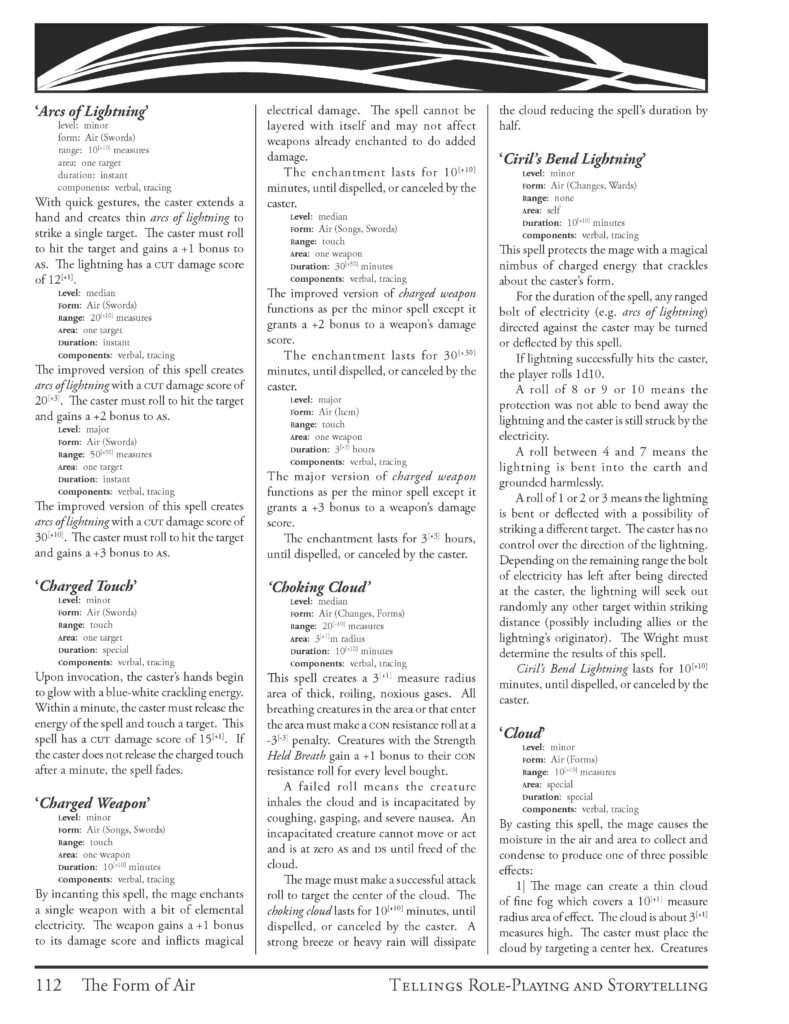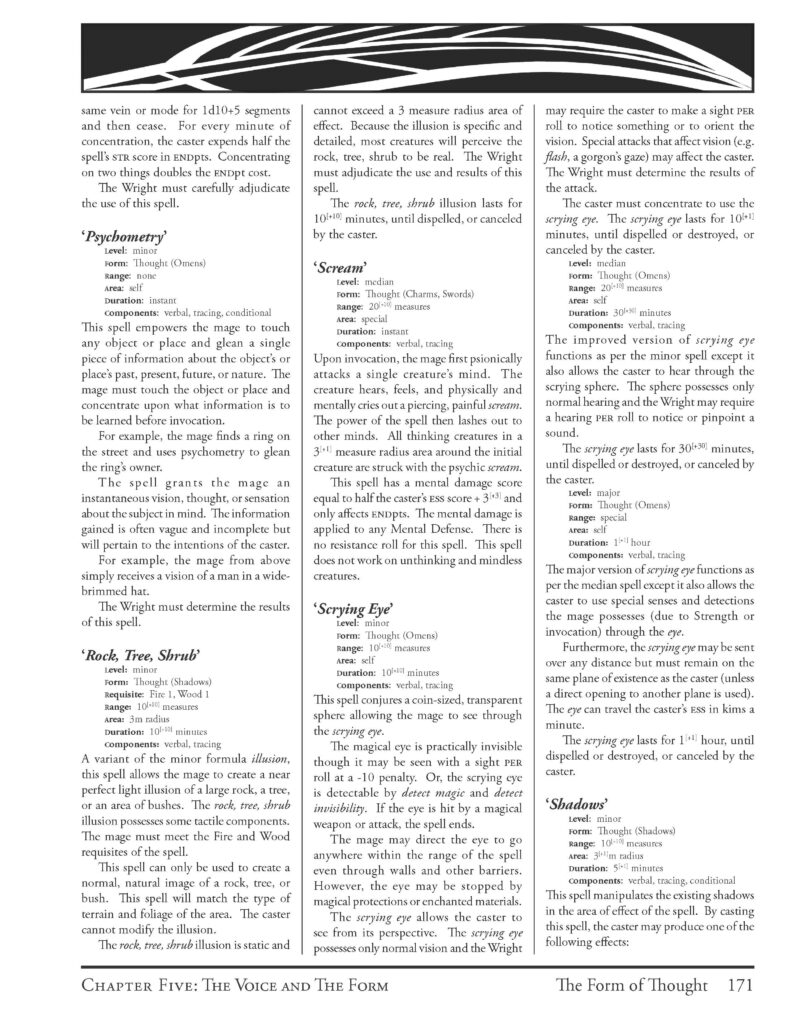
Magic in Tellings is flexible, fantastic, and fun giving players who enjoy playing mages, sorcerers, witches, enchanters, and even dabblers a range of specialized spells, effects, and mechanics. Magic is organized into eight forms or areas of mage- and spellcraft–Air, Earth, Fire, Water, Wood, Blood, Thought, and Power–with over 600 spells and formulae. Unlike other game systems, magic is different from the power of prayer; the rules and mechanics for mages is distinct from the rules and mechanics for priests. Spellcasting in Tellings allows mages to adjust and adapt their powers to need and circumstance, including surge casting and spontaneous casting.
The Voice and The Form
The power that bonds quantum particles together, that holds
planets in sway about a star, that gives green to trees, that sparks consciousness in minds is the essence of magic. Its greatest power is to create. Its subtlest power is to change. Its wisest power, to divine. Its most terrifying, to destroy.
Magic is potential—like sleeping thought—dreaming images without substance, whispering wishes without sound. The mage, the spell caster, wakes magic and gives it direction. Like a weaver with thread and loom, the mage willingly draws, measures, shuttles, and weaves the magic around them. Magic is medium, tool, language. It is the mage who conjures or abjures, combats or counsels, speaks or silences. Magic is also invention, will, and intuition. The mana grants power and the mage shapes it purpose, gives it focus, through the voice and the form.
Mana, itself, is sentience—existing knowing all existence—possessing the very essences of creation; it is the parent of all things, all energies. But it is sentience in seeming apathy, not acting nor reacting, not active nor wholly passive. It is sentience with the desire of gravity, the discretion of fire, the devotion of stone, and the cold consideration of time. It is seemingly uncaring and far distant from sapient understanding. However, mana is not silent. It breathes, whispers, cries, and sings. Mana’s sentience gives all creation words—names—voice.
It is the voice that defines, evokes, creates. The voice of gravity speaks differently than the voice of flame; the voice of iron sings with a register apart that of the voice of light. The many voices of all things become the single presence of magic. For the mage, the voice is the key to working magic. The voice is part sound, part thought, and part spirit. Only the mage feels, seeks, hears the voice. The voice shapes, controls, powers the spell, the formula, the mage’s intent. With the voice, the mage gathers the magic and gives it form.
The form is the shape of the spell. The form determines how the magic is to be used, applied, ordered, projected. The form is the structure, the scaffold, the face, the appearance of the spell. Whereas the voice draws the mana, the form gives it pattern, direction, purpose, and influence. The voice wakes mana, names it, commands it. The form spins mana, twists it, weaves it. For the mage, the form is the art of magic, the craft of magic, the school or discipline, the way of magical knowledge. Magic gains color, design, and special effect through form. The form defines magic as flame or frost, thought or flesh, animal, vegetable, or mineral, real or unreal.
Magic Sense, Magic Ability,
and Magic Technique
To command the voice and the form, a character must first have the Strength Magic Sense, which grants them the ability to feel, to “hear,” to know when magic is being drawn and used. The character must also have the Strength Magic Ability, which grants the ability to detect the presence of magic, to dispel magic, and most importantly to invoke magic. See Chapter Four for details on the Strengths Magic Sense and Magic Ability. See the later sections of this chapter for details on detecting, dispelling, and casting magic.
Once the character learns or develops the power to sense and use the voice, the character’s proficiency and strength in magic is defined by the skill Magic Technique. Magic Technique defines the character’s training, talents, specialization, and capacity for the forms or schools of magic. Every time Magic Technique is bought for a particular form or school, the character gains one Technique Point (TEC) in that area of magic. The more TECs the character has in a form, the greater their power and ability. Each investment in the Strength Magic Ability grants the character 3 TECs for free. Most spells require at least 3 TECs to invoke. See Chapter Three for the skill Magic Technique and see later sections for details on Technique Points.
The Voice
The voice is how the mage invokes the power, the energy, the force of magic. The voice instructs. The voice imagines. The voice commands the sentience of mana, the potential of magic to obey the mage’s control and creation. The voice is the language of magic, the focused intent of magic. Depending on the individual, the culture, the guild, or the game world, the voice has also been called the art, the gift, the will, the arcane, the craft, the first power, the true power.
Whenever a mage casts, he or she uses the voice—it is part will, part thought, part word, part vim. Though not wholly sound (even though spells often require verbal or musical components), the voice can be sensed, felt, heard by anyone of ability in the vicinity of the caster. The voice may touch other senses as well combining thought, sound, color, warmth, chill, touch, and emotion. Some describe the voice as incomprehensible whisperings, as the sound of far distant singing or breathing, or even as the rush of wind or water or fire. Others describe the voice as a tingling along the skin and a quickening of anticipation, as the distant but deep bass pulsing of a heart beating, or as the simple heightening of all the ambient sounds around the caster.
The Form
The form is the pattern that magic takes. The form is shape. The form is design. The form is intent become actuality. Like music or choreography, like an algorithm or set of instructions, the form defines the highs and lows, the textures and results, the function and parameters of magic. The voice is invocation and the form is manifestation. The form is magic realized.
There are eight form each defining a particular sphere of power or influence. The forms lend themselves to a specialization of effect, of substance, and of element. A mage may find talent in only a handful of forms or choose to spread their training to a number of ways of magic. As the mage gains in technique, they gain in knowledge, strength, and mastery in their chosen forms. It is this mastery over a specific energy, a specific matter, a specific power that makes a forms mage formidable.
The forms are divided into five elemental forms, two essential forms, and one metaessential form. The elemental forms grant control over primary materials and energies of the world, the building blocks of the universe. The elements are Air, Earth, Fire, Water, and Wood. The essential forms grant control over the patterns and processes of living, thinking beings. The essences are Blood and Thought. The metaessential form grants control over magic and mana itself. The metaessence is Power. Each allows for ability and proficiency with different domains of magic. However, the ways of magic are not rigidly discrete and certain spells may fall primarily into one form but may reach across one or more areas.
Air
The elemental form of Air grants the mage power over air and gases. This form also gives the caster power over the many aspects of weather such as wind, clouds, storm, and lightning. The form of Air is also called the form of Sky or the form of Wind.
Blood
The essential form of Blood grants the caster power over all things linked to the flesh and form of animals, humans, and other living creatures. The control and communication of animals falls in this sphere of power. The control over size, shape, blood, bone, and muscle fall under this sphere. However, the healing or restoration of wounds or damage cannot be done with mage magic; the power to heal and restore is the reserved privilege of priests and divine power (see Chapter Six for details on prayers and healing).
Furthermore, since the form of Blood deals with animation and the life force, most necromantic magics fall under this sphere. Corporeal necromancy comes with the form of Blood. Ethereal or spiritual necromancy comes in combination with the form of Thought and the form of Power. When combined with the elements of Wood and Earth, this form allows for the creation of golems and automatons.
The form of Blood is also called the form of Body or the form of Bone.
Earth
The elemental form of Earth grants the mage power over stone, metal, and other solids such as ceramics, crystal, and glass. In part, this form grants the caster the power over magnetism and gravity. This form does not affect wood or bone. The form of Earth is also called the form of Metal or the form of Stone.
Fire
The elemental form of Fire grants the caster power over spark, flame, combustion, and heat. Indirectly, this form grants the caster the ability to produce light as well as smoke.
Power
The metaessential form of Power grants the caster influence over the nature of magic itself and to the control, manipulation, and dispellation of magical energies. Dimensional and temporal magics fall into this sphere. Moreover, the form of Power is the way of conjuring and summoning. See this chapter for details on using and adjudicating summoning. Because of its metamagical and often potent effects, the form of Power is considered the rarest and often most guarded areas of magic.
Thought
The essential form of Thought grants the mage power over mind, memory, reasoning, and instinct. The form of the Thought affects things such as hatreds, fears, prejudices, and dreams. This form also grants the caster access to the power of psi and divination such as clairaudience, clairvoyance, telepathy, psychometry, and psychokinesis.
The form of Thought also grants the caster power to affect and augment perception. Thought combined with an element like Fire can create illusions, images, lights, sounds, sensations, and shifting appearances to change perception. See this chapter for details on using and adjudicating illusions.
The form of Thought is also called the form of Mind.
Water
The elemental form of Water grants the caster power over water and liquids including acids. This form also grants the caster power over ice and cold. This form does not affect Blood. The form of Water is also called the form of Sea or the form of Frost.
Wood
Finally, the elemental form of Wood grants the caster power over plants, trees, fungi, wood, and in part the spirit of the wilderness, forest, and nature. The form of Wood affects the different parts of green and growing things—leaves, branches, vines, spines, thorns, needles, roots, bark, sap, and spores.
Schools
The schools of magic provide an alternative philosophy and organization to the forms of magic. The player and the Wright may use schools to create a different kind of mage who specializes in styles of magic. The schools mage masters cause and effect rather than elements and essences. The schools mage understands the way magic destroys or the way magic transforms or the way magic divines whereas the forms mage understands all the ways fire destroys or all the ways the body can be transformed or all the ways the mind can see, hear, sense, and control. However, regardless if the mage uses forms or schools, both will refer to the art and spirit of magic as the voice and the form.
Instead of buying Magic Technique in the forms, the player may wish to buy TECs in the schools. The Weakness Choice of Magic can be taken for choices in schools rather than forms. Depending on the nature of the game world, the schools may or may not be useful or necessary. The Wright must determine the place and status of schools magic as well as how schools mages and forms mages differ. For example, a forms mage and schools mage cannot share formulae though the Wright may allow a Magic Research roll modified by spell level to translate one standard to another. A mage cannot have TECs in both forms and schools.
There are eleven schools of magic: Changes, Charms, Forms, Omens, Shadows, Songs, Souls, Swords, Towers, Travels, and Wards.
The school of Changes offers magics for transformation, alteration, augmentation, and manipulation. The spells of this school work to shape and shift matter, energy, flesh, and form.
The school of Charms grants magics that affect thought, emotion, dreams, and disposition.
The school of Forms offers magics that create, gather, and conjure.
The school of Omens offers magics that see, sense, augur, reveal, and detect as well as magics that measure, calculate, and identify. The spells of this school grant knowledge, precision, and divination.
The school of Shadows grants magics to create images, sounds, and sensations. The spells of this school deal in illusions, perceptions, and misdirection.
The school of Songs grants magics to empower, imbue, animate, and enchant. The creation of items of magic is often associated with the school of Songs.
The school of Souls grants magics over the dead, the undead, and the power to affect the life force to harm a living body.
The school of Swords offers magics that burn, cut, damage, and destroy.
The school of Towers grants magics over magic itself. Though few in number, the spells of this school are potent and work with the laws of magic or metamagic. Furthermore, many of the most powerful spells in any form are the reserved right and responsibility of the school of Towers.
The school of Travels offers magics for summoning. The spells of this school call powers, creatures, and effects from local or other existences. The magic of the school of Travels lie in distances, dimensions, teleportation, and time.
The school of Wards grants magics for defense, mitigation, and protection as well as magics for abjuration, negation, or cancellation. The spells of this school find power in armor, neutralization, counterspells, and dispellation.
Sample Spells
Below are a few excerpt pages from Chapter Five of Tellings:


